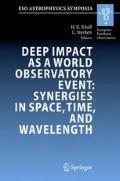abstract
The Deep Impact target comet 9P/Tempel 1 was observed by means of long-slit spectroscopy from two nights before impact up to eight nights after impact, using the ESO VLT UT1, UT2, and ESO NTT telescopes. Spectra covering the complete optical wavelength range were obtained, and information at different position angles in the coma was collected. The data were used to study the gas and dust activity of comet 9P/Tempel 1. Gas production rates before and after impact and the amount of material in the impact cloud were determined. The pre-impact $Afρ$ parameter, the dust production rate and the dust-to-gas mass ratio were derived. A variation of the cometary gas activity with rotation of the nucleus was detected. A difference in the variation of the brightness of the CN gas emission band compared to the variation of the emissions by $\rm C_2$, $\rm C_3$, and $\rm NH_2$ in the inner coma suggests compositional differences between different parts of the surface of comet 9P/Tempel 1’s nucleus.
Access this chapter
Tax calculation will be finalised at checkout
Purchases are for personal use only
Preview
Unable to display preview. Download preview PDF.
References.
M. F. A’Hearn, D. G. Schleicher, R. F. Millis, et al. (1984), ApJ, 89, 579
M. F. A’Hearn, M. J. S. Belton, W. A. Delamere, et al. (2005), Science, 310, 258
N. Divine: A simple radiation model of cometary dust for P/Halley. In: ESA SP-174: The Comet Halley. Dust and Gas Environment, ed by B. Battrick, E. Swallow, pp 47–53
P. D. Feldman, R. E. Lupu, S. R. McCandliss, et al. (2006), AJ, 647, L61
L. Haser, Bulletin de la Scociete Royale des Sciences de Liege (1957) 43, 740
L. Jorda (1995), Atmospheres cometaires: interpretation des observations dans le visible et comparaison avec les observations radio. PhD Thesis, Observatoire de Paris-Meudon, New York
M. Küppers, I. Bertini, S. Fornasier, et al. (2005), Nature, 437, 987
R. L. Newburn & H. Spinrad (1985), AJ, 90, 2591
H. Rauer, M. Weiler, C. Sterken, et al. (2006), A&A, 459, 257
G.P. Tozzi, H. Boehnhardt, L. Kolokolova, et al. (2007), Dust Observations of Comet 9P/Tempel 1 at the time of the Deep Impact, A&A \textbf{}, submitted
M. Weiler, H. Rauer, J. Knollenberg, et al. (2003), A&A, 403, 313
M. Weiler, H. Rauer, J. Helbert (2004), A&A, 414, 749
M. Weiler, H. Rauer, J. Knollenberg, et al., Icarus, in press (2007), URL: {\tt http://dx.doi.org/10.1016/j.icarus.2007.01.015}
Author information
Authors and Affiliations
Editor information
Editors and Affiliations
Rights and permissions
Copyright information
© 2009 Springer-Verlag Berlin Heidelberg
About this paper
Cite this paper
Weiler, M. et al. (2009). ESO Spectrophotometry of Comet 9P/Tempel 1. In: Käufl, H., Sterken, C. (eds) Deep Impact as a World Observatory Event: Synergies in Space, Time, and Wavelength. Eso Astrophysics Symposia. Springer, Berlin, Heidelberg. https://doi.org/10.1007/978-3-540-76959-0_36
Download citation
DOI: https://doi.org/10.1007/978-3-540-76959-0_36
Publisher Name: Springer, Berlin, Heidelberg
Print ISBN: 978-3-540-76958-3
Online ISBN: 978-3-540-76959-0
eBook Packages: Physics and AstronomyPhysics and Astronomy (R0)

